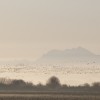 Dark clouds rush in from the west. On the wings of the storm, sea gulls race against the brooding sky. Just hours earlier, when faint wispy clouds first announced a change in weather, the steep mountains cast a perfect reflection on the glassy surface of the fjord. Tides running against a stiff breeze have meanwhile transformed the tranquil waters into a churning stretch of cresting waves. The heads of bald eagles paint white dots on the otherwise uniformly green canvas of forest, their bodies swaying as the trees they are perched on bend in submission to the gales. A Steller’s jay flutters noisily among the underbrush, announcing my presence to other forest dwellers. A black-tailed deer appears at the forest edge, glances in my direction and then melts back into the deep shadows among the trees. Off shore, on some rocks barely breaking the surface, several harbor seals lie hauled-out. As whitecaps crash against the outcrop, salty spray envelopes their bodies. In a sheltered bay, a blue heron stalks its prey. In the branches hanging above the water, kingfishers sit in ambush. A few wing beats away, a small river casts its tannin-stained load into the ocean. The salmon have started running. Dark shadows fight the strong current in unbroken succession to reach the spawning grounds beyond the rapids a few winding miles upstream. Both black and brown bears, in a rare display of tolerance for each other, gorge themselves on the seasonal overabundance along the watercourse. Eagles, crows and ravens argue over the scraps falling off the bears’ dinner table. A family of river otters, residents of the lower part of the river, join the feast. And occasionally, even the most elusive of denizens of this untamed land, the wolverine, visits the banquet prepared by nature.
Dark clouds rush in from the west. On the wings of the storm, sea gulls race against the brooding sky. Just hours earlier, when faint wispy clouds first announced a change in weather, the steep mountains cast a perfect reflection on the glassy surface of the fjord. Tides running against a stiff breeze have meanwhile transformed the tranquil waters into a churning stretch of cresting waves. The heads of bald eagles paint white dots on the otherwise uniformly green canvas of forest, their bodies swaying as the trees they are perched on bend in submission to the gales. A Steller’s jay flutters noisily among the underbrush, announcing my presence to other forest dwellers. A black-tailed deer appears at the forest edge, glances in my direction and then melts back into the deep shadows among the trees. Off shore, on some rocks barely breaking the surface, several harbor seals lie hauled-out. As whitecaps crash against the outcrop, salty spray envelopes their bodies. In a sheltered bay, a blue heron stalks its prey. In the branches hanging above the water, kingfishers sit in ambush. A few wing beats away, a small river casts its tannin-stained load into the ocean. The salmon have started running. Dark shadows fight the strong current in unbroken succession to reach the spawning grounds beyond the rapids a few winding miles upstream. Both black and brown bears, in a rare display of tolerance for each other, gorge themselves on the seasonal overabundance along the watercourse. Eagles, crows and ravens argue over the scraps falling off the bears’ dinner table. A family of river otters, residents of the lower part of the river, join the feast. And occasionally, even the most elusive of denizens of this untamed land, the wolverine, visits the banquet prepared by nature.
As if a faucet is opened wide, the rain begins to pour. The opposite side of the sound vanishes behind a curtain woven by fine strands of falling water blowing in the wind. Sheltered by the dense canopy above, my back supported by the base of a giant spruce, I sit between its roots and admire the forces unleashed.
Off the northwestwest coast of North America, in the shadow of lofty peaks, where the land peters out into the vastness of the Pacific, chains of islands lie separated from the mainland by a maze of narrow passages, deep fjords and long straits that funnel the wind and currents. Stitched together into a winding and twisting ribbon of water, these channels form a protected sea route that connects the ports and civic centers lining the shores of Puget Sound and the mouth of the Fraser River in the south with Skagway at the head of Taiya Inlet at the top of Alaska’s Panhandle in the north. During the gold rush, when ships of all sizes and shapes transported tens of thousands of stampeders up to the start of the Chilkoot trail and the new El Dorado on the Klondike beyond, this seaway was given the name “Inside Passage” to distinguish it from the alternative route along the outside on the storm-battered open Pacific. Today the term is often used more broadly, referring to the ocean and islands around the passage itself as well. In total, the entire area encompasses 40,000 miles of shoreline, several thousand islands, countless islets and stretches over 1,000 nautical miles from north to south.
